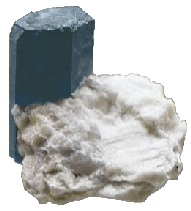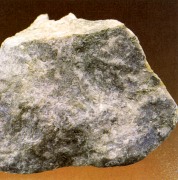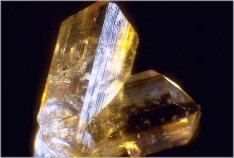 |
 |
 |
 |
| トリフィル石ルース(Facetted
triphylite) 1.08ct(7x5.5mm) & 1.6ct(7x6.2mm) 左は太陽光(left : daylight) 右は白熱光(right : incandescent light) Minas Gerais, Brazil |
5.85ct Boa Vista Minas Gerais Natural History Museum Los Angeles | ||
トリフィル石(Triphylite)
 |
 |
 |
 |
| トリフィル石ルース(Facetted
triphylite) 1.08ct(7x5.5mm) & 1.6ct(7x6.2mm) 左は太陽光(left : daylight) 右は白熱光(right : incandescent light) Minas Gerais, Brazil |
5.85ct Boa Vista Minas Gerais Natural History Museum Los Angeles | ||
 |
 |
 |
 |
|||
| 結晶形の見本のような結晶 産地不明(unknown locality) |
70mm Hagendorf, Germany |
幅 44mm New Port,New Hampshire U.S.A. |
リチオフィル石(Lithiophilite)双晶 Foot Mine Kings Mtn. North Carolina U.S.A. |
| 化学組成 (Composition) |
結晶形 (Crystal form) |
結晶系 (Crystal System) |
モース硬度 (Hardness) |
比重 (Density) |
屈折率 (Refractive Index) |
| Li(Fe2+,Mn2+)PO4 |  |
斜方晶系 (Orthorhombic) |
4 - 5 | 3.34-58 | 1.672-675 |
名前について (About name)
トリフィル石の名はギリシア語の ”treis=三つの””phulon=種類、族” に因んで1834年に命名されました。
と言ってもそれでは何の事か分かりません。色々調べてみたところ、三つの種類とは成分中に含まれる三つの陽イオンのことだそうです。
これといった特色のない鉱物だったせいでしょう、如何にも苦し紛れにつけた衒学的な命名に思えます。
と、書きましたが、後述のように、これは未来のリチウムイオン電池の正電極材料に使われる鉱物の名前としては実に先見性に富んだ命名でした。
Triphylite was name in 1834 by Fuchs after Greek word "treis=three and phulon=kind,family". Three kind seems to mean three cations in the compositon. Although I wrote this naming pedantic, this naming turned out to be far-sighted one for a mineral to be employed as an ideal cathode for the most advanced lithium-ion battery, as described later.
産地と産状(Origine and Occurence)
トリフィル石はペグマタイト鉱脈にアンブリゴ石、スポジューメン、錫石、緑柱石等と共に発見されます。
産出は稀でドイツの Hagendorf、ポルトガルの Mangualde、チェコの Pribyslavice、スウェーデンの Norrö、アメリカの New Hampshire、ナミビアの Karibib 等が主な産地です。
宝石質の結晶は殆どがブラジル、ミナスジェライス州のペグマタイトに発見されます。
Triphylite is a rare mineral occurs in granitic pegmatite associated with many secondary phosphate, such as amblygonite, triplite, and lithiophilite(LiMn[PO4]) as solid solution. Spodumen, cassiterite and beryl are often associated.
Large triphylite crystals up to 1.5m across are known from Hagendorf, Germany ; other localities are Pribyslavice, Tcheco, Norrö, Sweden, Mangualde, Portugal, karibib, Namibia, Tanco Mine, Manitoba, Canada, New Hampshire, South Dakota, and California, U.S.A.
Almost all gemmy crystals are mined from pegmatites in Minas Gerais, Brazil.
純粋なトリフィル石はマンガンを含みませんが、現実には常にマンガンを含み、鉄分を含まないリチオフィル石 (LiMn[PO4]) との連続的な固溶体として産出します。
太陽光下ではくすんだ灰緑を帯びた褐色の下級品の紅柱石(アンダルーサイト)のように見えます。
Although pure triphylite does not include manganese, but all triphylite mined include man ganese as solid solution with litiophylite.
Facetted triphylite looks like greysh-green colored low-grade andalusite under daylite.
左の写真はネット上でアレクサンドライトのような色変わりをするトリフィル石ということで、おお!と早速注文しました。
実際に届いたのは冒頭の1.6ctのオクタゴン・カットのまことに冴えない石で、確かに白熱光下では鮮紅色に変貌しました。
同じく1.08ctの楕円カットの石は十数年前に入手したものですが,ためしに白熱光下で見たら同じように鮮紅色になりました。
どうやらトリフィル石は強い白熱光下では鮮やかな発色をするようです。
もっとも強い白熱光下では大抵の宝石は鮮やかに見えますから、アレクサンドライト効果というのは誇大広告も良いところです。
宝石のルースは照明等によって色合いが著しく変りますから、ネット上の写真だけを見て注文するのはリスクが大きいという教訓です。
Photo is an example of facetted stone, introduced as an alexandrite-like color change triphylite, on internet. The actual stone delivered is the 1.6ct octagone stone as shown in top photo. Although it showed color change under incandescent light, as well as another 1.08ct oval stone I had obtained in the past.Triphylite seems to be a mineral that shows color change, which, however is not spectacular as alexandrite, at all. We should be careful to order facetted stone, simply on photos on internet.トリフィル石の用途 (Bright Potential of Triphylite)
コレクター向けの冴えない宝石標本にしかならないトリフィル石ですが、実は次世代の高性能リチウムイオン電池の正電極材料として注目されています。
電極の材料と構造とは電池の性能を左右する最も重要な要素ですが、何とトリフィル石が画期的な正電極素材として開発が進められているのだそうです。
実際に使われるのは合成のトリフィル石ですが、天然のトリフィル石を使った電極でも充放電が可能と言うことです。
三つの陽イオンという名前は正電極材料になる鉱物名としては、これほど相応しいものはないでしょう。
近い将来、合成のトリフィル石が全てのリチウム電池に使われる日がやって来るかもしれません。
すると、その副産物として美しい合成トリフィル石の宝石が市場に現れるかもしれません。
詳細は2007年1月の日本電気化学会でのセミナーにてトリフィル石の合成と実用研究に携わっている三井造船(株)の研究発表で行われる、と研究者の方から教えていただきました。
Despite poor appearance of triphyilite, facetted only for gem collectors, triphylite now attracts hot attention for it's great potential as an ideal cathode material for lithium-ion battery of future automobile. Cathode material and structure are the most important factors to determine the performance of battery and triphylite is now extensively studied as an ideal cathode material. Even natural triphylite is acknowledged to perform as cathode material, although synthetic one will be finally employed. We should say that the triphylite was correctly named in 1834 for its ultimate purpose as cathode material in 21st century. Lets' expect that attractive gem triphylite will debut as the bi-products of synthetic triphylite for battery use, in the near future.
| Top | Gemhall |